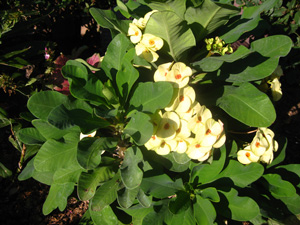Resource Library
Plant of the Week: Crown-of-Thorns
The University of Arkansas System Division of Agriculture does not promote, support or recommend plants featured in "Plant of the Week." Please consult your local Extension office for plants suitable for your region.
Plant of the Week
Crown-of-Thorns Hybrids
Latin: Euphorbia x lomi

Most gardeners know of crown-of-thorns (Euphorbia millii) and shun it as an old-fashioned houseplant with a thorny, sprawling look that falls into the “more interesting than beautiful” category. But in recent years, the crown-of-thorns has been reborn and deserves a second look.
The new crown-of-thorns hybrids are best referred to as belonging to selections of E. x lomi, crosses between E. lophogona and the original, long-cultivated E. millii. Both species are native to desert areas of Madagascar, though the hybrid never occurred in the wild and is strictly man-made. Euphorbia lophogona is an erect growing, minimally branched evergreen with large leaves and modest-sized thorns up its branches. The more familiar E. millii is a low growing, much-branched plant with flowering bracts in many shades of pink, red and yellow.
The origins of the modern Tai hybrids are a bit murky, but it appears that they arose from crossing previous hybrids of these two species that had been developed in California and Germany. The large and robust nature of the Tai hybrids, with cultivars numbering in the hundreds, makes me believe that probably the ploidy level (chromosome number) was increased somewhere along the way. The hybrids made their worldwide debut about 1991 and found ready acceptance in the then-emerging container planting market.
The Tai hybrids combine the best features of the two parents. The plants are upright, growing with clean and deep-green 4 inch-long leaves that are retained on the plant better than on E. millii. Plants are strong growers with moderate branching and can reach 5 feet in height, given enough time and protection from freezing conditions. Thorniness varies amongst the cultivars, but in general, plants are less thorny than the original crown-of-thorns.
Flower colors are in shades of pink, salmon, red, orange, yellow and bicolor. The showy portion of the terminal inflorescence of these hybrids is a modified pair of bracts called cyathophylls. The bracts of the hybrids are usually 1 inch across and produced in terminal clusters, usually with eight cyathophylls in each cluster. Flower buds are set in the leaf axils of each leaf, so it is not uncommon to see heads of 4 or more inches across. Unlike E. millii, which tends to flower best during the short days of the year, the hybrids are day-length insensitive and form flower buds as long as the plant is growing.
These new hybrid crown-of-thorns are easy-to-grow plants that tolerate average growing conditions in the ground or in a container. If grown in a container with other plants, care should be exercised to match growth rates so that the crown-of-thorns is not overwhelmed by the foliage of a faster-growing neighbor. The crown-of-thorns is frost-tender and can be taken indoors during the winter, where it makes an easy-to-grow houseplant.
As long as the soil media is well drained, these new hybrids perform well with routine watering. However, because their native habitat is the desert, they will survive drought better than most other common container plants. Excessive and prolonged drought will cause leaf drop, with the remaining leaves concentrated at the ends of the stems. Plants grow and flower best in full sun but will tolerate up to 30 percent shading and continue to bloom.
Like all euphorbs, the crown-of-thorns produces a milky sap that can cause dermatitis in sensitive individuals. Special care should be exercised to keep the sap away from the eyes.
By: Gerald Klingaman, retired
Retired Extension Horticulturist - Ornamentals
Extension News - March 4, 2011
The University of Arkansas System Division of Agriculture does not maintain lists of retail outlets where these plants can be purchased. Please check your local nursery or other retail outlets to ask about the availability of these plants for your growing area.